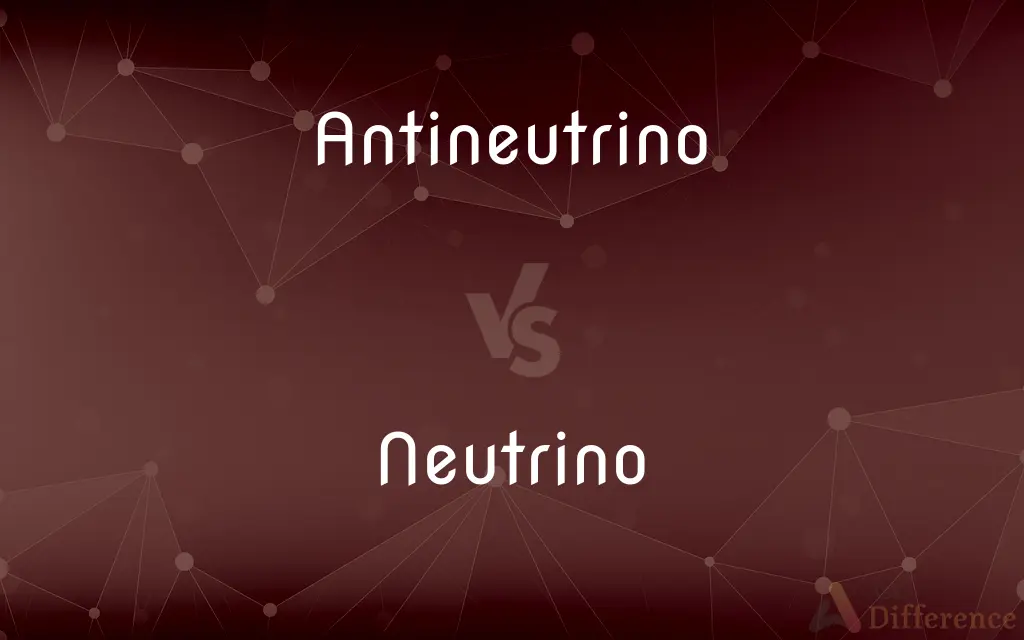Antineutrino vs. Neutrino — What's the Difference?
By Tayyaba Rehman — Updated on September 28, 2023
Amphiprotic substances can either donate or accept a proton; Polyprotic substances can donate more than one proton.

Difference Between Antineutrino and Neutrino
Table of Contents
ADVERTISEMENT
Key Differences
Amphiprotic and Polyprotic substances are terms used to describe substances based on their ability to donate or accept protons (H+ ions) in solutions. An Amphiprotic substance has the ability to act either as an acid or a base, meaning it can either donate or accept a proton. Water is a classic example of an amphiprotic substance because it can donate a proton to act as an acid, or accept a proton to act as a base.
Polyprotic substances, on the other hand, are substances that can donate more than one proton per molecule. They possess multiple ionizable hydrogen atoms, allowing them to release more than one proton in sequential reactions. Sulfuric acid (H₂SO₄) is a common example of a polyprotic acid as it can donate two protons in successive steps.
The differentiation between amphiprotic and polyprotic is pivotal for understanding chemical reactions, particularly in the field of acid-base chemistry. Amphiprotic substances exhibit versatility in their proton interaction by either donating or accepting, adapting to the chemical environment they are in. Polyprotic substances, with their ability to release multiple protons, can significantly influence the acidity of a solution.
In practical applications, recognizing whether a substance is amphiprotic or polyprotic is crucial for predicting its behavior in chemical reactions and its impact on the pH of solutions. For instance, the amphiprotic nature of amino acids is critical for protein structure and function, and the polyprotic characteristic of certain acids is vital for industrial processes.
Understanding these terms and the inherent properties of substances categorized as such provides invaluable insight into their reactivity, interaction with other substances, and their subsequent effect on the chemical composition of solutions. It can aid in developing advanced materials, pharmaceuticals, and in various chemical processes.
ADVERTISEMENT
Comparison Chart
Definition
Can either donate or accept a proton.
Can donate more than one proton.
Nature
Acts either as an acid or a base.
Acts as an acid with multiple ionizable hydrogens.
Example
Water is amphiprotic.
Sulfuric acid is polyprotic.
Impact on pH
Can alter pH by donating or accepting protons.
Can significantly alter pH by releasing multiple protons.
Application
Critical for protein structure and function.
Vital for industrial processes and chemical synthesis.
Compare with Definitions
Antineutrino
A substance that can either lose or gain a hydrogen ion in a reaction.
The amphiprotic nature of amino acids is essential for protein formations.
Neutrino
A substance that can donate more than one proton per molecule.
Sulfuric acid is polyprotic, releasing two protons sequentially.
Antineutrino
Capable of reacting as either an acid or a base.
Bicarbonate ion is amphiprotic, interacting with both acids and bases.
Neutrino
Characterized by the ability to release several protons in stepwise dissociation.
Polyprotic substances require multiple steps to fully dissociate in solutions.
Antineutrino
Characterized by the ability to interchangeably act as an acid or a base.
Amphiprotic substances are vital in balancing chemical equations due to their versatile nature.
Neutrino
Represents acids that can undergo more than one ionization.
Understanding polyprotic acids is fundamental for predicting pH levels in chemical reactions.
Antineutrino
A substance that can either donate or accept a proton.
Water is amphiprotic as it can donate or accept a proton depending on the environment.
Neutrino
Having the capacity to lose more than one proton in acid-base reactions.
The study of polyprotic substances is crucial for advanced material development and industrial applications.
Antineutrino
Exhibiting dual behavior in acid-base chemistry by either releasing or accepting protons.
Amphiprotic substances play a crucial role in maintaining physiological pH.
Neutrino
Possessing multiple ionizable hydrogen atoms.
Polyprotic acids significantly influence solution acidity due to multiple proton donations.
Antineutrino
The antiparticle of a neutrino.
Neutrino
A neutrino ( or ) (denoted by the Greek letter ν) is a fermion (an elementary particle with spin of 1/2) that interacts only via the weak interaction and gravity. The neutrino is so named because it is electrically neutral and because its rest mass is so small (-ino) that it was long thought to be zero.
Antineutrino
(particle) The antiparticle of the neutrino. Category:en:Antimatter
Neutrino
Any of three electrically neutral leptons (the electron neutrino, muon neutrino, and tau neutrino—one in each of the three generations of elementary fermions) that have very small masses.
Antineutrino
The antiparticle of a neutrino. Each type of neutrino has a corresponding antineutrino.
Neutrino
An elementary particle that is classified as a lepton, and has an extremely small but nonzero mass and no electric charge. It interacts with the surroundings only via the weak force or gravitation, making it very difficult to detect.
Antineutrino
The antiparticle of a neutrino
Neutrino
An elementary particle with zero charge and zero mass
Common Curiosities
Do polyprotic acids release all their protons at once?
No, polyprotic acids usually release their protons sequentially in stepwise dissociations.
Can amphiprotic substances donate and accept protons simultaneously?
Amphiprotic substances can either donate or accept protons depending on the environment, but not simultaneously in the same environment.
Are all polyprotic substances also amphiprotic?
No, while all amphiprotic substances can act as either acids or bases, not all polyprotic substances can accept protons.
Share Your Discovery

Previous Comparison
Evangelise vs. Evangelize
Next Comparison
Shorthand vs. SymbolAuthor Spotlight
Written by
Tayyaba RehmanTayyaba Rehman is a distinguished writer, currently serving as a primary contributor to askdifference.com. As a researcher in semantics and etymology, Tayyaba's passion for the complexity of languages and their distinctions has found a perfect home on the platform. Tayyaba delves into the intricacies of language, distinguishing between commonly confused words and phrases, thereby providing clarity for readers worldwide.














































